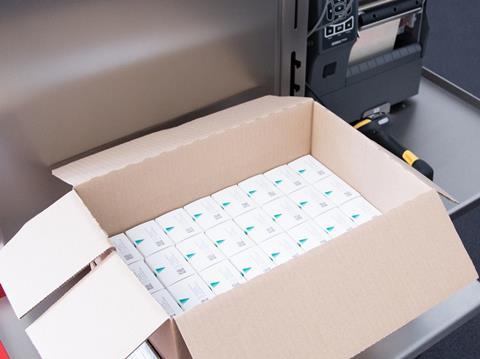
The Russian Federal Law No. 488-FZ, effective on January 1, 2019, regulates implementation of the serialisation code with cryptographic protection.
WIPOTEC has closely followed the developments in Russia, and developed an upgrade kit for TQS solutions that offers advanced printer and camera technology to meet the needs of the Russian market. This upgrade kit is now available for all new and existing TQS systems. The upgrade kit allows a pharmaceutical manufacturer to meet the requirements of the Russian legislation, even when using particularly small and sophisticated packaging formats. WIPOTEC also offers the option of printing the data matrix code in its usual size of 12.7x12.7 mm and smaller. High-resolution cameras inspect the serialisation codes with cryptographic protection in accordance with the ISO 15415:2011 standard. In addition, there is the possibility to enlarge the code up to 25.4x25.4 mm in order to achieve a higher process reliability by maintaining the common module size.
Russian Code Structure
Russian serialisation code will consist of two parts: The first part of the code is the, "identification part" and is comprised of a sequence of characters representing the unique number of the item. The second part is for control and verification and represents a sequence of characters formed as a result of a cryptographic transformation of an identification code. These cryptographic characters are intended to expose counterfeit codes during their verification. Due to the cryptographic transformation, the data set to be coded more than doubles compared to the GS1 DataMatrix used in the European Union.

Infrastructure and Crypto-system provider
The system provider is responsible for successful introduction of serialisation and clarification of any details as well as administration and evaluation of the resulting data. Until November 2018, the system was operated by the Ministry of Taxation of the Russian Federation. Since then, the new operator has been the Center for Advanced Technology Development (CRPT). CRPT provides for allocation of crypto characters and transfer of the required data, as well as installation of Issue Recorders at the respective production sites. These devices will be connected to the national cloud. The pharma producer transmits serial numbers together with the GTIN to the cloud and in return receives the corresponding cryptographic key for the code to be printed and verified. The model provides for a fee to be charged for each cryptographic key; in addition, annual maintenance costs for the Issue Recorder are under discussion.
Aggregation process remains unchanged
The process of aggregation of serialised products, which includes aggregation into cartons and further into pallets, will be the same as in other countries. For this purpose SSCC codes with GS1-128 data structure will be utilized. No changes from the Russian side are to be expected here so far.
12 product groups to be seriallised
In the course of the coming year, various product groups are to be serialised for traceability purposes. The new law requires implementation of serialisation activities in a uniform national system. At present, this system provides for 12 different product groups which will require serialisation. In addition to pharmaceutical products, the system also covers shoes, clothing, tobacco, and alcohol. In the long term, the system will cover all products.
















